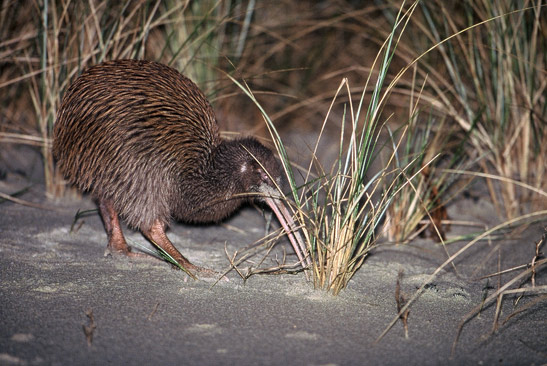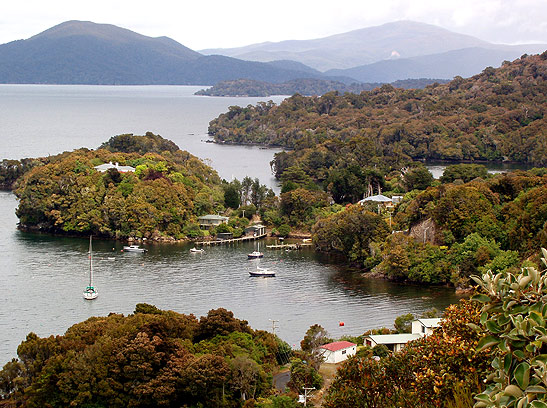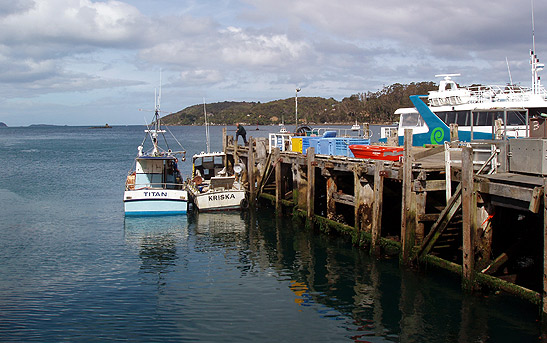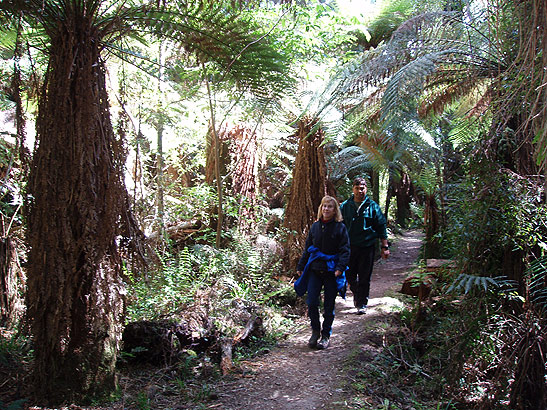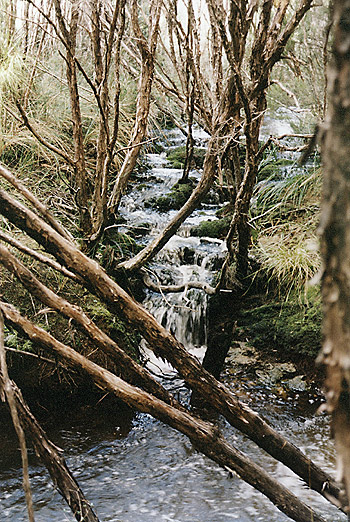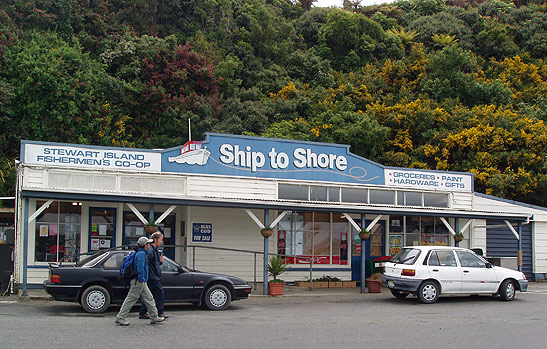 |
 |
|
 |

|
Stewart Island:
The "Other" New Zealand Island By Fyllis Hockman On orders to stay close, we waddled in muted tandem behind guide Philip Smith as he inched us to within 20 feet. Trying not to intrude upon her late-night supper, we were star-struck by this brown dumpling of a bird, head bobbing up and down, its long beak darting in and out of the sand single-mindedly nibbling on spiders, berries and crustaceans.
Stewart Island, 674 isolated square miles of land to the south of South Island that very few New Zealanders visit, much less anyone else, is the only place in New Zealand where you can spot kiwis, the native bird that few natives ever see. According to Wendy Hallett, owner of the Greenvale B&B where we stayed, many people first book a kiwi-spotting tour with Smith, THEN book their trip to New Zealand and Stewart Island. But there are many reasons to visit Stewart Island other than the kiwi. Alternately described as isolated, insular, undeveloped, natural, wild, Stewart Island beckons in a way few modern destinations do. The downside? All the things that make it so appealing as a destination (unless, of course, you're looking for luxury resorts and chic nightclubs) might themselves be ultimately destroyed by those to whom it so appeals. Hopefully, it's inaccessibility -- if the flights or ferry can't travel because of the weather, neither can the tourists - and its uber-emphasis on conservation might preserve it against the expected onslaught.
There is a very lived-on, lived-in feel about the island; everyday life is happening here, albeit probably not your everyday life. As one of the waitresses at the Just Café noted: "We have no banks, no doctors, no t-shirt shops (not literally true, but more on that later) … and no stress." Ask anyone how many people in town and you might hear something like: "Well, 400 at last count - no, wait - Annie just gave birth to the twins and Rupert died last week, so guess that makes 401." And that number remained constant despite several efforts on my part to find an alternate answer. Eighty-five percent of Stewart Island was designated in 2002 as Rakiura National Park, making it the most recent addition to New Zealand's vast string of national parks. While there are only 18 miles of road on the island, there are 174 miles of walking trails (called tracks), ranging from a 15-minute stroll through the bush to 3-hour hike to a 10-day trek. Basically, there are two ways to get around -- by boat and on foot. You gotta love a place that has more water taxis than land ones.
A favorite hike was the Maori Beach Track, a 15-minute water taxi ride from downtown -- which, by the way, covers about a one-block area. Captain Ian, a 6th-generation islander, carried me effortlessly across the slippery, moss-covered log he parked the water-cab against. Alternately walking through bush so thick as to be impenetrable or hugging the craggy cliff overlooking the sea, we were bombarded by a new form of surround sound: the thrashing of waves crashing below and the concert cries of birds overhead.
The varying vocals from tuis, bellbirds, kakas and kakarikais were reminiscent of the array of voices one hears in a noisy restaurant: sometimes individual cries dominated, other times, a general din prevailed. Then suddenly the birds were vying for attention once again with the breaking waves. We heard the water before we saw it, as the expanse of coastline made yet another appearance. The most natural destination upon our return to town was the South Seas, of course - the only bar in the only hotel on the island. This gives "local bar" a whole new meaning. Stocking-cap-clad men, just off their fishing boats, with long beards and high boots best each other at billiards and darts. The room overflows with men and women drinking with gusto, laughing over town gossip or bemoaning the latest catch. This is not a place that serves a lot of light beer. What it does serve is good food in ample portions, the fish in the fish 'n chips just about the flakiest I've had, and the fries, crisp and tasty. The other must-do activity -- like the calling of the kiwi -- is to board another water-taxi for a visit to Ulva Island. "This is the forest primeval, the murmuring pines and the hemlocks…" begins Walt Whitman's famous poem, Evangeline. He also could have been describing Ulva Island, an untouched ("unmodified" is the technical term), predator-free, primitive slice of New Zealand the way it once was.
And that very nature of the island makes it an unparalleled sanctuary for birds, trees and plants that might otherwise be extinct. The hard-wood podocarp forest, literally of pre-historic ancestry, also houses species of plants 350 million years old. Rare birds such as the fernbird, saddleback, rifleman and yellowhead roam the woods with impunity. And the inhabitants are not the only things special about Ulva Island; there's also Ulva Goodwillie, another 6th-generation Stewart Islander whose breadth and scope of knowledge covers every twig, branch and feather found on Ulva Island. The similarity in names may be coincidental but it's one hell of a marketing tool. She conducts half- and full-day tours of the island, communicating with the trees and the birds in very personal, intimate terms, distinguishing between every caw, chirp, click, creak, twill or whistle emanating from the treetops. One of my tour companions likened the sounds to an "avian symphony." "If I could get them organized, I could take them on tour," my musically inclined friend observed. Back on the mainland, a stop at the Ship to Shore general store provides another insight into island living. This is the place to pick up groceries, hardware, beer and wine, household goods, fishing and hunting equipment and videos. Videos? But for major food shopping, residents are dependent upon the supermarket in Invercargill, South Island (the real mainland). They pick up their orders at the Halfmoon Bay waterfront every Wednesday evening.
Next to Ship to Shore is the previously alluded to T-shirt shop -- although the designation is really a misnomer. Dil Belworthy, like so many other Islanders, was a fisherman by trade and, like so many of his compatriots, several years ago "saw the writing on the wall." As he tells the story, "I was drinking with some mates one day and we were discussing how the fishing industry was going downhill, and how we saw tourism on the horizon." With tourists as their new prey, the question became: "How do you catch a tourist?" The answer: "You sell them a T-shirt!" So Dil and his wife, Cath, started hand-printing their art-shirts on their kitchen table in 1997, reproducing native Maori symbols and traditional images. Now, their Glowing Sky Studio sells these individually designed and produced wearable works of beauty for $35 per non-T-shirt T-shirt. For sure, Stewart Island as a whole has learned well how to catch tourists, but it wouldn't surprise me if the islanders have mixed emotions about just how successful they want their new venture to be. For more information, visit www.stewartisland.co.nz. Related Articles: (Posted
4-7-2011) |
|
This site is designed and maintained by WYNK Marketing. Send all technical issues to: support@wynkmarketing.com

|











